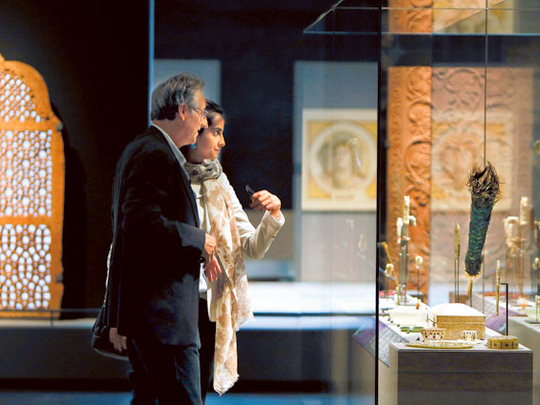
Paris: This city’s famed Louvre museum this week opens a new wing of Islamic art in a bid to improve knowledge of a religion often viewed with suspicion in the West.
Costing nearly €100 million ($131 million, Dh481 million), it is funded by the French government and supported by handsome endowments from Saudi Arabia, Morocco, Kuwait, Oman and Azerbaijan.
About 3,000 precious works from the seventh to the 19th centuries are spread across 3,000 square metres over two levels. The exhibits will be rotated.
The project was a brainchild of French former president Jacques Chirac and dates back to 2001.
It groups 18,000 treasures from an area spanning from Europe to India and includes the oldest love missive in the Islamic world.
France is home to at least four million Muslims and leaders of the community say incidents of Islamophobia are on the rise against a background of confrontation with the authorities and rising suspicion of Muslims.
Many Muslims in France have been angered by legislation banning women from wearing full veils and this year’s elections were marked by debate over the use of halal methods of animal slaughter.
The tensions were highlighted by the one of the main movers behind the project, Sophie Makariou, the head of the department of Islamic arts at the Louvre, who said the aim is to show “Islam with a capital I.”
“That means the civilisation as a whole, not with a small ‘i’ designating just the religious sphere,” she said.
“We must give back the word Islam its full glory... and not leave it to the jihadists to tarnish it,” she said.
“Islamic art is not confined to the art of the Muslim community. It is the art of all those who comprised the Islamic world and in it there were Christians and Jews,” she said, referring to mixed populations in several Islamic empires.
Set in a courtyard commissioned in the 18th century, it is housed under a giant undulating gold-coloured aluminium canopy pierced with tiny holes to let daylight filter through and change the mood and the ambience with the sun’s rays.
“You can call it a flying carpet, a huge tent, a luminous veil or simply golden clouds,” said the canopy’s designer, Italian architect Mario Bellini.
The canopy consists of 2,350 netted triangles fitted together.
“The challenge was not to overwhelm the western language of the courtyard with the collection,” he said. “It had to be discreet and in tune with one of the world’s best-known monuments,” he said.
The artefacts from the Louvre’s own collection and other private ones include Moghul-era carpets from India, miniature paintings from Iran showing depictions from the Thousand and One Nights and an astounding silver and gold inlaid basin from Egypt or Syria and dating between 1330 and 1340.
The basin was used for the baptism of France’s King Louis XIII and bears the inscription “Work of Master Muhammed ibn al-Zayn”.
Makariou pointed to a delicate alabaster-like vase from Syria with Islamic calligraphy as one of the highlights.
“It is from Susa and goes back to the ninth century. It is a love letter penned on a vase as was the custom then. It is the oldest known love letter from the Islamic world,” she said.
“We have several other shards penned by the same hand,” she said. “We are eagerly awaiting to piece them together.”
The collection brings together pieces from Spain, Egypt’s Mameluke “slave” dynasty, the Mughal empire in India, Persia and Central Asia.
It also recreates the grandeur of Baghdad, the founding of which in 762 was a major event in urban planning history, with a reproduction of two huge mosaics adorning the Grand Mosque there.
There is also a teak door from a palace in Samarra on the banks of the Tigris with an Art-Nouveau-style fan-shaped motif ending in a lobed leaf.
A myriad of calligraphic styles are also on display with stunning turquoise and white tiles from Central Asia, bejewelled ornaments and ivory objects d’art and enamelled glass objects — an art form conceived and perfected by Muslims.
It is the latest modernisation project after the glass pyramid in the Louvre’s main courtyard by Chinese-US architect I.M. Pei which was commissioned in 1984 and completed four years later.
Saudi Prince Waleed Bin Talal’s Alwaleed Foundation, which gave $20 million for the project, said it hoped the “space shall bring much-needed understanding and tolerance by offering visitors... a glimpse of Islamic civilisation and culture.”
The Saudi prince said at the time of the donation that “relations between Europe and the Islamic world are going through a turbulent period.”
He said he hoped the new wing “will assist in the understanding of the true meaning of Islam, a religion of humanity, forgiveness and acceptance of other cultures.”
French President Francois Hollande opened the wing officially yesterday, with the public getting the first glimpse on Saturday.












